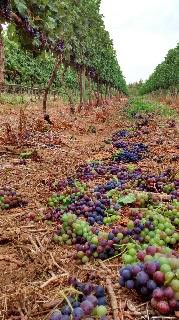Vintage Report 2014
Click here for our current vintage report
2002 2003 2004 2005 2006 2007 2008 2009 2010 2011 2012 2013 2014 2015 2016 2017 2018 2019 2020 2021 2022
Merlot 2014
As difficult this vintage was in the vineyard, as beautifully it developed in the cellar through the twelve month of barrel maturation. During this time, the wines were racked twice, and complemented with a dash of both Malbec and Cabernet Sauvignon from neighboring vineyards. Not unlike the 2013 wines, they now convince with delicate aromas, supple tannins and elegant stature.
As absolute novelty, we produced this year for the first time the Merlot Forte 2014, a wine made from partly dried grapes and barrel-matured for two years. It is a powerful wine with a strong character, concentrated and intensely flavored, a protagonist on its own.
Good news also for our vegan customers: from 2014 onwards, we will abstain from the use of traditional fining agents of animal origin such as milk or egg white, as we have occasionally used previously in small quantities for the fining of tannins in our Little and Pink Merlot. In other words, from 2014 onwards, all our wines will be guaranteed vegan.
- Merlot Forte 2014: our newest child
is a novelty wine made from partly dried grapes and matured for two
years in tight-grain 2nd-fill French oak barrels.
Hand-picked on 22nd of March 2014, carefully selected bunches were laid
out in special drying crates and allowed to partly raisin in the open
air. Once the grapes have lost 30% of their weight, they were gently
destemmed and fermented on the skins during three weeks. The wine was
then set to mature in 225L French 2nd-fill oak barrique for 24 months. It was
bottled on 15 April 2016, unfined and only gently filtered.
Naturally, as the grapes shrivel, sugars, acids, tannins, flavors and other components concentrate, which gives this wine its distinctive bold character and naturally high alcohol. This makes it the ultimate wine to crown a gourmet meal or to complement a rich dessert or mature cheese.
- only 600x375ml bottles have been produced.
Alc 17.5%Vol, Extract 43.2gr/l, RS 9g/lt, TA 6.2g/l - Bein Merlot 2014: Our flagship wine
is this year's finest selection from the best
batches of our vineyard. This vintage was matured in 60% new and 40% second fill
barrels, Of rather elegant stature, it convinces with velvety
tannins, balance and complexity. The new oak is well integrated and
harmonizes well with the delicate fruit. This vintage might be
earlier accessible, but will develop well over the next ten years.
- 7750 bottles produced; Alc 14.3%, TA 4.9 g/l, pH 3.6
Expected maturation potential -2025 - Little Merlot 2014 : The specifically selected fruit
from more vigorous sections of our vineyard, a shorter maceration
time and the cautious maturation regime in barrels of the 3rd and
4th generation yielded a pleasantly fruity and early accessible
wine. Nevertheless, this wine is full of power and vitality and can
be matured for at least another five years.
6850 bottles produced; Alc 13.6%, TA 5.6 g/lt, pH 3.52
Released July 2014, best till 2019 - Pink Merlot 2014: a dry, fruity-fresh rosé.
Harvested 4 weeks earlier than our red wines, from the vigorous parts of our vineyard, this wine pleases like every year with red berry aromas and crisp freshness. Bottled in late May in 3320 bottles, for early drinking pleasure. Alc 13.04%, RS 4.3 g/l, TA 4.6 g/l, pH 3.27
Detailed vintage report: Season 2013-14
A new child is born, the Merlot Forte!
This vintage brought about the creation of a completely new wine, our Merlot Forte 2014. It
is a novelty wine made from partly dried grapes and matured for two
years in tight-grain 2nd-fill French oak barrels. It is a powerful wine
with a strong character, concentrated and intensely flavored, a
protagonist on its own.

Hand-picked on 22nd of March 2014, carefully selected bunches were laid
out in special drying crates and allowed to partly raisin in the open
air. Once the grapes have lost 30% of their weight, they were gently
destemmed and fermented on the skins during three weeks. The wine is set to mature in 225L French oak barrique for 24 months. It was
bottled on 15 April 2016, unfined and only gently filtered.
Naturally, as the grapes shrivel, sugars, acids, tannins, flavors and
other components concentrate, which gives this wine its distinctive bold
character and naturally high alcohol. This makes it the ultimate wine
to crown a gourmet meal, to complement a rich dessert or mature cheese;
or simply enjoy on its own :-)
March/April 2014: Good wine takes time
After the rosé came in so perfectly, the harvest of the main crop was
all the more difficult. Lots of patience and even more hard work was
asked.
Patience, because it kept on raining as harvest approached, and
we had to wait and wait for the ideal time to pick. It was even more hard work, because
the rot caused by the rain had to be sorted out in countless extra hours.
We eventually harvested in stages, from 27 March up to 9 April, the latest
ever on our farm.
Fortunately, the fruit set was plentiful and we could generously sort
out any bad parts. So despite all the adversities, we could eventually bring in a good crop. The resulting wines look promising and are likely to become
similar to the 2013, with fine aromas, wonderfully supple, ripe tannins
and elegant structure.
February 28, 2014: Harvest
After the rainy start of the season, February began with a heat wave. However, this was followed by a period of beautiful weather, so harvest began under ideal conditions. We started on 28 February with the crop for our rosé, which is always harvested a few weeks before the main harvest. These grapes were super healthy and tasty, and the resulting wine was wonderfully tangy and aromatic.
January 2014: Veraison
 The
new year has continued the series of untimely rains. Shortly after New
Year's, we had strong rain again. Whoever did not react in time -
despite it being farmer’s holiday – risked major failures. Extra effort
was needed to guard against downy mildew (Peronospora). All in all, we
had more than twice as much rain as usual from September to January,
which made the vintage 2013-14 quite challenging for the viticulturist.
On the other hand, where everything went fine, the fruit developed
bountifully, so we expect a very good harvest, both qualitatively
and quantitatively.
The
new year has continued the series of untimely rains. Shortly after New
Year's, we had strong rain again. Whoever did not react in time -
despite it being farmer’s holiday – risked major failures. Extra effort
was needed to guard against downy mildew (Peronospora). All in all, we
had more than twice as much rain as usual from September to January,
which made the vintage 2013-14 quite challenging for the viticulturist.
On the other hand, where everything went fine, the fruit developed
bountifully, so we expect a very good harvest, both qualitatively
and quantitatively.
By January 20, our grapes started changing color, a process called
veraison, which takes about 10 days. This is the ideal time to identify
and eventually remove late-ripening bunches, the so-called "Green
Harvest", which turned out scarily abundant this year, as the picture
shows.
December 2013
For a change, December 2013 was dry and hot. The only rainy day just after Christmas was this time a welcome refreshment for vines and vintner. Also the seasonal winds held back. The good soil water reserves, together with the warm weather, however, led to a strong vegetative growth, so we spent a lot of time in the vineyard for canopy management. Of course, the weeds loved the good conditions as well and necessitated extra effort to be kept in check.
November 2013: Flowering time
November, i.e. early summer and thus flowering time of the vines,
promised beautiful weather. But there were torrential rains in
mid-November, which caused serious flooding in lower lying areas of
other regions.
Rain at this time also interferes with the flowering of the vines, and
depending on the grape variety, some winemakers might have to expect a
significant harvest reduction. In addition, heavy rains promote the
development of downy mildew (Peronospora), a fungus that attacks both leaves and inflorescences.
Careful planning and a good
preventive control program were crucial to survive this period without
losses.
September-October 2013: Spring
After the cool and rainy winter, budding only began in mid-September, two weeks later than usual. This phase was accompanied by occasionally heavy rains, at times too much for the oversaturated soils, resulting in heavy erosion with deep dongas on many exposed slopes. Luckily, the following month, October, was comparatively dry and warm, so that the vines now developed vigorously everywhere.
August 2013 - Winter Work
Winter is usually a quiet time for us. This year, however, we had
to replace all the vines burnt by the fire which raged last year through
our vineyard. The damage was worse than initially estimated, and we had
to replant over 500 vines. This means digging 500 plant holes of
one cubic meter each, to prepare the soil for optimal root development.
In an established vineyard, this is quite a mission. The video clip
tells you more about it.

